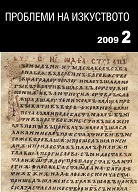Мотивите на тератологичните инициали в руските ръкописи от ХІІІ век. Някои наблюдения
The Motifs of the Teratological Initials in the Russian Manuscripts from the 13th Century. Some Observations
Author(s): Engelina SmirnovaSubject(s): Cultural history
Published by: Институт за изследване на изкуствата, Българска академия на науките
Summary/Abstract: The initials of the Gospel Lectionary from A .D . 1270 are examined in this study . In the past the Lectionary was known under No 105 in the collection of count Rumiantzev, while at present it is kept in Russian State Library in Moscow . The manuscript was ordered by Simon, a monk of the Novgorodian Yuriev monastery . In the initials, among other motifs, there are image compositions, alluding to Christ or to the issues of good, wisdom and grace: the lion, the dove, the Sirin-bird, the peli- can, King David . A special place is given to the images of snake, coiled around a tree, as a symbol of evil and temptation . These initials are not exemplifications of Gospel episodes, but pictorial implications, allegorical admonitions of different events and ideas from the Gospel . Almost all of them (except the snake on the tree) can change their places since they are grounded on general allusions and not on concrete indications to a situation . As the comparison of several Russian Gospel Lectionaries from the end of 12th-13 c . shows, some of the motifs in their initials are identical . however, in every single manuscript these motifs are localized in different places, in their own manner . It is impossible to establish any permanent connection between a text and a motif of an initial . The choice of the initial was spontaneously made by the artist according to his own incentive . Additional argument to the claim that the motifs in the initials have been rationalized is the concentration of Christological allusions at the end of the Lectionary, where the Menology and Sunday Gospel readings are placed . In the 14th century the teratological compositions in the Russian initials became entangled and decorative, loosing their connection with the text .
Journal: Проблеми на изкуството
- Issue Year: 2009
- Issue No: 2
- Page Range: 21-25
- Page Count: 5
- Language: Bulgarian
- Content File-PDF

